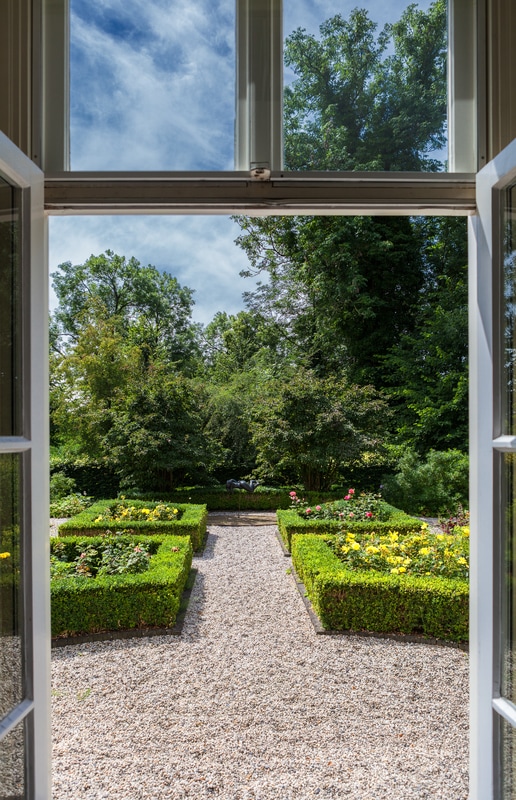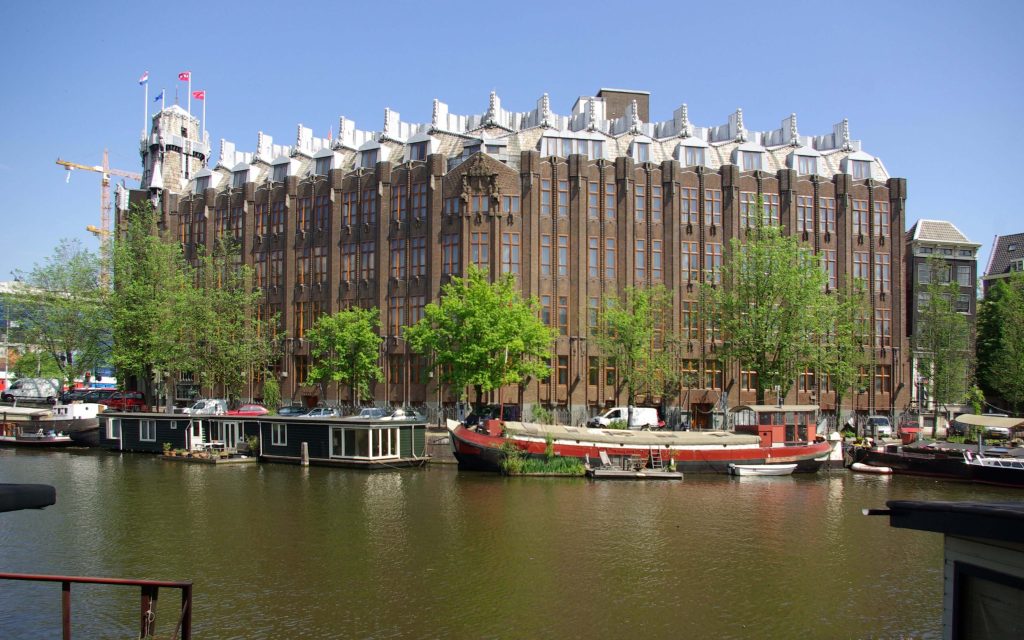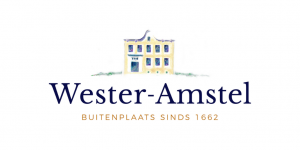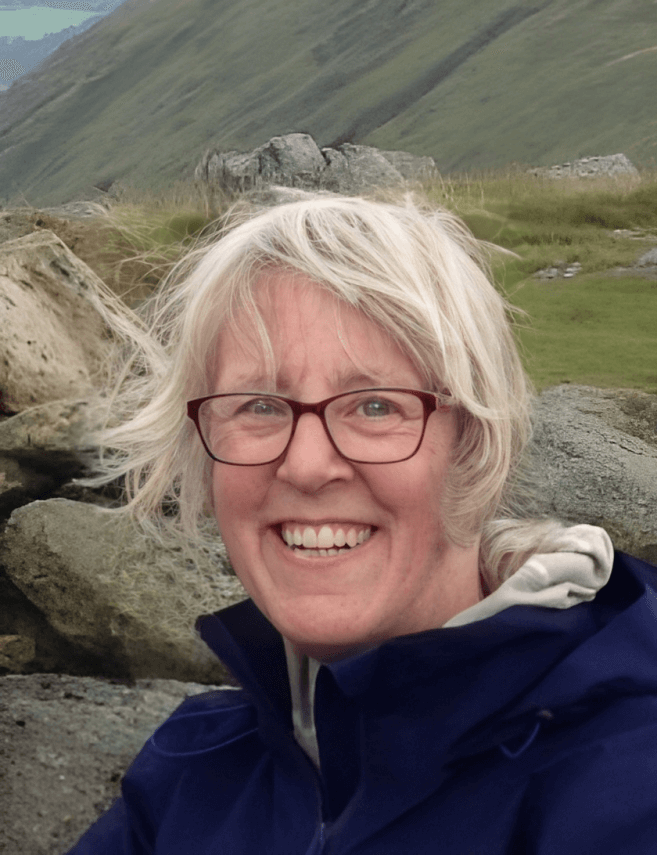For this edition of Friends of Wester-Amstel, I sat down with our new Garden Group coordinator – Clasien Slebos. While she may be a fresh face around the country estate, Clasien is fully embracing her new role and ensuring that everything runs as smoothly as possible in our gardens.
Speaking of gardens, I was pleasantly surprised by the weather during our chat. Despite it being the end of November, there was not a cloud in the sky. It was wonderfully sunny Sunday in the Ornamental Garden. I later found out that I had Clasien to thank for that (you’ll have to keep reading to find out why).
During our chat, I learned more about Clasien’s background in city planning, her passion for monuments, and how she ended up at Wester-Amstel. And one thing is for sure… For someone who never thought they would spend her days off in the garden, Clasien’s thumb is certainly turning greener by the day.

Taylor Blades: Thank you for meeting with me today. Can you please introduce yourself to our readers?
Clasien Slebos: I'm Clasien Slebos, the new Garden Group coordinator. I’ve been volunteering here for a year. Interestingly enough though, prior to coming to Wester-Amstel, I had never worked in a garden before. Or at least not one of this size or scope.
Taylor: Really? That’s a fun fact. How did you come across Wester-Amstel actually?
Clasien: I fell in love with Wester-Amstel while cycling past it during trips along the Amstel River. But really, I was inspired to learn more about it after quitting my office job.
Taylor: Oh really? Tell me more about this.
Clasien: My first degree was in city planning. I graduated from that and I got a job in the field of traffic and transport. I worked there for many years, before deciding to go back to school and get a second degree, this time in art and architecture history.
Upon completing my degree, I began working for the City of Amsterdam, in its Monuments and Archaeology Department. I worked on several large projects, two days a week. Simply put: I'm quite interested in monuments. So much so that I now lead tours in Amsterdam centred around architecture, city planning, and so on.
This interest eventually drew me to Wester-Amstel. You see, architecture used to be my hobby, but then I turned it into a job. Therefore, I needed a new hobby! And in the end, gardening became exactly that. Gardening is one of the things that suits the "new" Clasien who no longer works in an office.
Taylor: It sounds like you spend a lot of time outside now - working in the garden, leading tours in Amsterdam.
Clasien: It’s true and you know what is strange? It rarely ever rains when I'm outside.
Taylor: Then you are very lucky because let's face it... It rains a lot in the Netherlands.
Clasien: I must be because I can't remember giving a single tour in the rain.
Taylor: Just to paint a picture to all our readers... We’re sitting in the Ornamental Garden right now and the sun is shining. There isn’t a cloud in the sky. But moving on, can you tell me a bit more about the tours you give?
Clasien: In one of the tours, we explore Amsterdam West and its post-Second World War architecture and art. In another, we walk through De Pijp and look at the architectural style known as "Amsterdam School". This style was popular in the Netherlands between 1920 - 1930. I've also led tours on Fort Island Pampus, which is a UNESCO World Heritage site. The tours I give different tours each time. This year, for example, I started giving tours at Wester-Amstel.

Taylor: You seem like you know a lot about Amsterdam and its surrounding area!
Clasien: I feel like I do. I was born here, studied here, worked in city planning for 30 years, and now I also have a background in architecture history.
Taylor: Besides our fantastic garden, what inspired you to volunteer here?
Clasien: As I mentioned, I'm quite interested in monuments and, well, this is a monument. *looks around at Wester-Amstel* It really is the complete package. It's a beautiful buitenplaats with a fantastic building, park, orchard, and gardens. And its history dates back hundreds of years. It is interesting to think that people used to come here by trekschuit (a horse-drawn boat that is specific to the Netherlands). When you walk through those gates, you feel the history, but it’s no wonder since it was built in 1662.
Taylor: Did you know much about Wester-Amstel before coming here?
Clasien: I only knew it was a country house. Now that I know more, I like the fact that Wester-Amstel is not only a monument, but it is also a place steeped in memories. The steward can recount stories about his family going back to 1900. He can tell you about what his family did here, and what life was like at Wester-Amstel before it was open to the public. These personal stories add an extra layer to this place, making it even more inviting.
And of course, when you are giving a tour to a group it is always nice to have a formal explanation, to tell people why something is a monument, how the park used to be organised, in what style the garden is laid out in, and so on... But when you are able to bring the great auntie or great grandfather into the picture, that is what pulls people in on a different level.
Taylor: What is it like working alongside the other Garden Group volunteers? Are you learning a lot from them?
Clasien: They are professionals. They know a lot and they know what everyone has to do and what tasks have to be done. And this is very important for me.
Taylor: That is very true. There are plans, goals, and plenty of passion. So, is it safe to assume that you enjoy volunteering here?
Clasien: Yes, more than I would have expected! I always say that there is an invisible glue that sticks to you. Once you are here, you never want to leave. And I'm not the only person who feels this way. You hear many people say, "Oh I only came here by accident, but now..." Personally, I like that there is a lot to do here. You can visit the garden and park, you can go to a concert, or stop by during Amstelland Day or Open Monuments Day.

Wester-Amstel is a place where things can happen. For example, the Garden Group wanted to reinvigorate a wild area behind the kitchen garden with special bushes for birds. It was a big project, but we did it. And in a few years, once the bushes have matured, the birds will feast on berries.
Taylor: How did you become the Garden Groups' new coordinator?
Clasien: I began thinking about it when Els Hulsing step down from the role. I thought to myself, "There are plenty of people in the Garden Group who know a lot more about plants than I do. So what can I do? What can I contribute?" Since I have some experience in managing projects, I hoped I would be able to help coordinate the group.
Taylor: Can you tell me more about the role?
Clasien: I have no big ambitions or plans for change. I like the job of being like an invisible hand. I'm here to help ensure everything runs smoothly. I talk to and look for new volunteers. I discuss what projects or tasks the Garden Group can do. I look at the budget to see what we can buy. I help with many little things and make decisions when necessary - like what day of the week will we work in the garden, those types of things. When I accepted this position, I made sure to speak to all of the Garden Group volunteers individually. I wanted to get to know them and see if they had any requests. This is what we are looking into now. Basically, I look to see how we can organise things better and make sure people enjoy volunteering in the garden. I focus on these types of things so that they can focus on the garden.
I'm the invisible, organising hand, but I'm certainly not the leader. There is no one leader, we work together and run this group together. Everyone has their area of expertise. One person might be well-versed in the kitchen garden, whereas another person in the herb garden, and so on. Everyone has unique knowledge and interests. One thing is for certain though, when there is a difficult or not so fun task, we all cooperate and finish it as a team... The quicker we do it, the sooner we can enjoy a cup of coffee together.
Taylor: Have you learned anything interesting while working in the garden?
Clasien: I learn so much every week, especially when I work in the kitchen garden. How they grow everything, how long it takes, and what we can do with the different parts of the plant. I learn so many practical things. I'm also always surprised by all the new vegetables and fruits I'm discovering here. There's so much to learn that I haven't even made it to the herb, bee, ornamental, or cottage gardens yet! There is still a lot for me to discover.
Taylor: They are always growing new things in the gardens. They are very creative and adventurous.
Clasien: They also ensure that there is always something growing - regardless of the time of year. In the autumn, there are still beautiful flowers blooming. And even in winter, you can harvest things! I didn't even know that was possible! I thought you could only grow things in greenhouses during the winter months, but that is not the case.
Taylor: What do you enjoy about Wester-Amstel and do you have a favourite spot to sit and just relax?
Clasien: I enjoy cycling here. It is roughly a seven-kilometre journey, but it is always a pleasure. Whether it is a sunny morning, or foggy… like it was today. I also like that by the time I get home, I'm really tired. Working outside tires you out, but in a good way. And of course, I enjoy having coffee (after a morning of hard work) with great people.
As for a spot I like to sit… I like the benches that overlook the meadows, especially the one on the left-hand side. And while you can see large buildings in the distance, I'm happy that the meadows are protected so that no one can build anything on them in the future.
Taylor: What value do places like Wester-Amstel have for the Netherlands and in communities like Amstelveen?
Clasien: I think when it comes to history, it is very important to have physical reminders of where we came from. What is was like in the past, how things developed, and so on. Whether it is good or bad, we are reminded of how it all came to be. Places like Wester-Amstel allow us to learn from the past and take this information with us to the future. They combine history with actuality, which are all things I’m happy to dedicate my time to.
By: Taylor Blades

